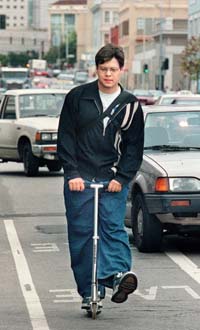Scooter Mania

Not just for kids anymore
by Holly Hartman |
New York businessmen depend on them, Japanese teenagers can't live without them, and they're all the rage among Israeli schoolchildren. The simple scooter is supreme.
 A San Francisco "scooter-commuter" |
When else has a toy been so many things to so many people? "Scooter-commuters" zip along New York City sidewalks. Policemen ride scooters in Berlin. At some Wal-marts, employees scoot down the megastore's endless aisles. Scooters are handy for restaurant deliveries. But lest you worry that scooters are too ordinary, consider this: Prince Harry is said to scoot the long halls of the royal palaces.
The streamlined silver scooters people are riding today debuted in Germany in 1993. These nifty new toys became a craze elsewhere in Europe, Australia, and Asia before reaching North American shores. By spring 2000, New York City, southern California, and Hawaii had become the U.S. scooter centers. Meanwhile, in Japan scooters are a national obsession.
A Yen to ScootIn crowded Japan, people often bike between home and the trains that take them to work or school. At many train stations, bike parking has become a problem, and foldable scooters offer a perfect solution. An estimated 75,000 are sold each week, and people wanting to buy scooters may have to wait months.
Not just commuters but elderly people in Japan use scooters to make simple travel easier. Teenagers and kids use them for kicks (and sometimes gravity-defying tricks), while other fans have practically made scootering a sport.
Four years ago Naoya Nishinaga, now 23, traveled from one end of Japan to the other on his foot-powered scooter. He then did 5,000 kilometers (over 3,000 miles) along the coast of Australia before packing self and scooter off to Europe. On the road Nishinaga scoots about 70 kilometers (43 miles) a day, alternating legs every few pushes so as to build muscle evenly.
Putting on the BrakesFoot-powered scooters travel about 4 m.ph., while motorized models can go closer to 15 m.p.h. That's just fast enough that some people consider the toys a nuisance—careless riders have knocked down pedestrians, and scooting criminals have made off with handbags and other loot.
Despite their widespread popularity, the sleek toys have sparked worries and complaints. They can be unsafe in the street but are often illegal on sidewalks or bike paths. No traffic rules apply to them, and few of their riders wear helmets.
Currently, scooters are illegal in Canada's Quebec province. Although police often ignore scooting, in theory scooting to work in Montreal could bring fines of up to US$90. And since several English policemen were knocked over by speedy scooters, there has been a movement to ban scooters within the City of London.
Once Upon a ScooterScooters were invented in Germany in 1817. In the United States, scooters first enjoyed wide popularity during the Great Depression, when many children built their own scooters from recycled wood. Scooters had a small surge of popularity in the 1950s and were trendy off and on until pretty much being replaced by skateboards in the 1980s.
Unlike bikes, scooters are portable—you can fold one up and stash it in a backpack. Unlike cars, they're relatively cheap and don't need to be fed. And they're safer and easier to use than skateboards or roller blades. The most popular U.S. model weighs 6 pounds and costs about $100.
